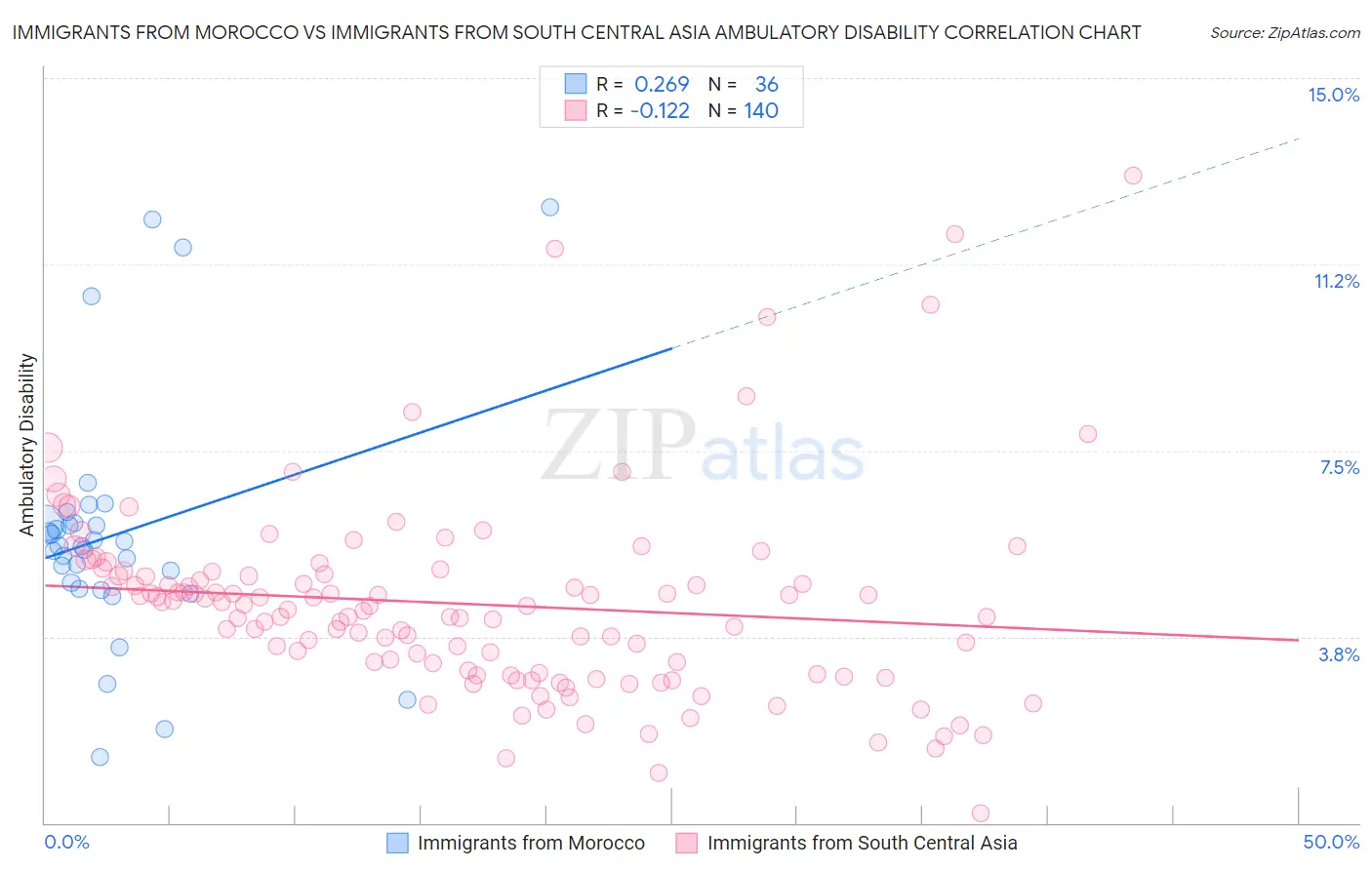Immigrants from Morocco vs Immigrants from South Central Asia Ambulatory Disability
COMPARE
Immigrants from Morocco
Immigrants from South Central Asia
Ambulatory Disability
Ambulatory Disability Comparison
Immigrants from Morocco
Immigrants from South Central Asia
5.8%
AMBULATORY DISABILITY
97.3/ 100
METRIC RATING
106th/ 347
METRIC RANK
5.1%
AMBULATORY DISABILITY
100.0/ 100
METRIC RATING
8th/ 347
METRIC RANK
Immigrants from Morocco vs Immigrants from South Central Asia Ambulatory Disability Correlation Chart
The statistical analysis conducted on geographies consisting of 178,910,370 people shows a weak positive correlation between the proportion of Immigrants from Morocco and percentage of population with ambulatory disability in the United States with a correlation coefficient (R) of 0.269 and weighted average of 5.8%. Similarly, the statistical analysis conducted on geographies consisting of 472,870,749 people shows a poor negative correlation between the proportion of Immigrants from South Central Asia and percentage of population with ambulatory disability in the United States with a correlation coefficient (R) of -0.122 and weighted average of 5.1%, a difference of 14.1%.

Ambulatory Disability Correlation Summary
| Measurement | Immigrants from Morocco | Immigrants from South Central Asia |
| Minimum | 1.3% | 0.18% |
| Maximum | 12.4% | 13.0% |
| Range | 11.1% | 12.9% |
| Mean | 5.8% | 4.4% |
| Median | 5.6% | 4.4% |
| Interquartile 25% (IQ1) | 4.8% | 3.0% |
| Interquartile 75% (IQ3) | 6.0% | 5.0% |
| Interquartile Range (IQR) | 1.3% | 2.0% |
| Standard Deviation (Sample) | 2.5% | 2.0% |
| Standard Deviation (Population) | 2.4% | 2.0% |
Similar Demographics by Ambulatory Disability
Demographics Similar to Immigrants from Morocco by Ambulatory Disability
In terms of ambulatory disability, the demographic groups most similar to Immigrants from Morocco are Uruguayan (5.8%, a difference of 0.050%), Immigrants from Czechoslovakia (5.8%, a difference of 0.070%), Colombian (5.8%, a difference of 0.070%), Immigrants from Netherlands (5.8%, a difference of 0.080%), and New Zealander (5.8%, a difference of 0.18%).
| Demographics | Rating | Rank | Ambulatory Disability |
| Immigrants | Northern Europe | 98.2 /100 | #99 | Exceptional 5.8% |
| Immigrants | Serbia | 97.9 /100 | #100 | Exceptional 5.8% |
| Immigrants | South America | 97.9 /100 | #101 | Exceptional 5.8% |
| Immigrants | Kenya | 97.8 /100 | #102 | Exceptional 5.8% |
| Immigrants | Romania | 97.7 /100 | #103 | Exceptional 5.8% |
| New Zealanders | 97.6 /100 | #104 | Exceptional 5.8% |
| Immigrants | Czechoslovakia | 97.4 /100 | #105 | Exceptional 5.8% |
| Immigrants | Morocco | 97.3 /100 | #106 | Exceptional 5.8% |
| Uruguayans | 97.2 /100 | #107 | Exceptional 5.8% |
| Colombians | 97.2 /100 | #108 | Exceptional 5.8% |
| Immigrants | Netherlands | 97.1 /100 | #109 | Exceptional 5.8% |
| Immigrants | Colombia | 96.7 /100 | #110 | Exceptional 5.8% |
| Danes | 96.6 /100 | #111 | Exceptional 5.8% |
| South Africans | 96.3 /100 | #112 | Exceptional 5.9% |
| Immigrants | Uruguay | 95.6 /100 | #113 | Exceptional 5.9% |
Demographics Similar to Immigrants from South Central Asia by Ambulatory Disability
In terms of ambulatory disability, the demographic groups most similar to Immigrants from South Central Asia are Iranian (5.1%, a difference of 0.36%), Yup'ik (5.2%, a difference of 0.97%), Bolivian (5.1%, a difference of 0.99%), Immigrants from Bolivia (5.0%, a difference of 1.4%), and Immigrants from Singapore (5.0%, a difference of 2.1%).
| Demographics | Rating | Rank | Ambulatory Disability |
| Immigrants | India | 100.0 /100 | #1 | Exceptional 4.8% |
| Filipinos | 100.0 /100 | #2 | Exceptional 4.9% |
| Thais | 100.0 /100 | #3 | Exceptional 4.9% |
| Immigrants | Taiwan | 100.0 /100 | #4 | Exceptional 4.9% |
| Immigrants | Singapore | 100.0 /100 | #5 | Exceptional 5.0% |
| Immigrants | Bolivia | 100.0 /100 | #6 | Exceptional 5.0% |
| Bolivians | 100.0 /100 | #7 | Exceptional 5.1% |
| Immigrants | South Central Asia | 100.0 /100 | #8 | Exceptional 5.1% |
| Iranians | 100.0 /100 | #9 | Exceptional 5.1% |
| Yup'ik | 100.0 /100 | #10 | Exceptional 5.2% |
| Immigrants | Korea | 100.0 /100 | #11 | Exceptional 5.2% |
| Okinawans | 100.0 /100 | #12 | Exceptional 5.3% |
| Burmese | 100.0 /100 | #13 | Exceptional 5.3% |
| Immigrants | Eastern Asia | 100.0 /100 | #14 | Exceptional 5.3% |
| Immigrants | China | 100.0 /100 | #15 | Exceptional 5.3% |